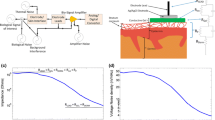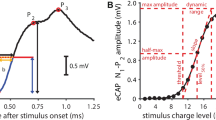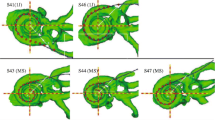Abstract
Physiology of the cochlea and auditory nerve can be assessed with electrocochleography (ECochG), a technique that involves measuring auditory evoked potentials from an electrode placed near or within the cochlea. Research, clinical, and operating room applications of ECochG have in part centered on measuring the auditory nerve compound action potential (AP) amplitude, the summating potential (SP) amplitude, and the ratio of the two (SP/AP). Despite the common use of ECochG, the variability of repeated amplitude measurements for individuals and groups is not well understood. We analyzed ECochG measurements made with a tympanic membrane electrode in a group of younger normal-hearing participants to characterize the within-participant and group-level variability for the AP amplitude, SP amplitude, and SP/AP amplitude ratio. Results show that the measurements have substantial variability and that, especially with smaller sample sizes, significant reduction in variability can be obtained by averaging measurements across repeated electrode placements within subjects. Using a Bayesian-based model of the data, we generated simulated data to predict minimum detectable differences in AP and SP amplitudes for experiments with a given number of participants and repeated measurements. Our findings provide evidence-based recommendations for the design and sample size determination of future experiments using ECochG amplitude measurements, and the evaluation of previous publications in terms of sensitivity to detecting experimental effects on ECochG amplitude measurements. Accounting for the variability of ECochG measurements should result in more consistent results in the clinical and basic assessments of hearing and hearing loss, either hidden or overt.












Similar content being viewed by others
Data Availability
Additional code and data are available from the corresponding author upon request.
Notes
Source code can be accessed at https://github.com/myKungFu//Bayesian-ECochG
Abbreviations
- AP :
-
Compound action potential
- SP:
-
Summating potential
- IM:
-
Independent measures experiment
- RM:
-
Repeated measures experiment
- I :
-
Number of subjects in each group
- J :
-
Number of repeated measurements made
- \(Y\) :
-
Amplitude measurement, either AP, SP, measured from humans or simulated
- \(\gamma\) :
-
True underlying amplitude (dB re: 0.07 μV)
- \(\widehat{\gamma }\) :
-
Estimated underlying amplitude (dB re: 0.07 μV)
- \(\varepsilon\) :
-
True error in repeated measurements (dB)
- \(\widehat{\varepsilon }\) :
-
Estimated error in repeated measurements (dB)
- \(d\) :
-
Difference in amplitude (dB)
- \({d}_{\mathrm{min}}\) :
-
Minimum detectable difference (dB) for a given condition
- \({\sigma }_{d}\) :
-
Standard deviation of the average difference in amplitude across subjects (dB)
- \({\Delta }_{H0}\) :
-
Vector of simulated differences under the null hypothesis of no amplitude change
- \({\Delta }_{H1}\) :
-
Vector of simulated differences under the alternative hypothesis of amplitude change
References
Earl BR, Chertoff ME (2010) Predicting auditory nerve survival using the compound action potential. Ear Hear 31:7–21
Goldstein MH, Kiang NYS (1958) Synchrony of neural activity in electric responses evoked by transient acoustic stimuli. J Acoust Soc Am 30:107–114
Durrant JD, Wang J, Ding DL, Salvi RJ (1998) Are inner or outer hair cells the source of summating potentials recorded from the round window? J Acoust Soc Am 104:370–377
Hancock KE, O’Brien B, Santarelli R, Liberman MC, Maison SF (2021) The summating potential in human electrocochleography: Gaussian models and Fourier analysis. J Acoust Soc Am 150:2492
Lichtenhan JT, Hartsock JJ, Gill RM, Guinan JJ Jr, Salt AN (2014) The auditory nerve overlapped waveform (ANOW) originates in the cochlear apex. J Assoc Res Otolaryngol 15:395–411
Lutz BT, Hutson KA, Trecca EMC, Hamby M, Fitzpatrick DC (2022) Neural contributions to the cochlear summating potential: spiking and dendritic components. J Assoc Res Otolaryngol 23:351–363
Pappa AK, Hutson KA, Scott WC, Wilson JD, Fox KE, Masood MM, Giardina CK, Pulver SH, Grana GD, Askew C, Fitzpatrick DC (2019) Hair cell and neural contributions to the cochlear summating potential. J Neurophysiol 121:2163–2180
Harris KC, Bao J (2022) Optimizing non-invasive functional markers for cochlear deafferentation based on electrocochleography and auditory brainstem responses. J Acoust Soc Am 151:2802
McClaskey CM, Dias JW, Dubno JR, Harris KC (2018) Reliability of measures of N1 peak amplitude of the compound action potential in younger and older adults. J Speech Lang Hear Res 61:2422–2430
Prendergast G, Tu W, Guest H, Millman RE, Kluk K, Couth S, Munro KJ, Plack CJ (2018) Supra-threshold auditory brainstem response amplitudes in humans: test-retest reliability, electrode montage and noise exposure. Hear Res 364:38–47
Doros G, Lew R (2010) Design based on intra-class correlation coefficients. Am J Biostat 1:1–8
Bramhall N, Beach EF, Epp B, Le Prell CG, Lopez-Poveda EA, Plack CJ, Schaette R, Verhulst S, Canlon B (2019) The search for noise-induced cochlear synaptopathy in humans: mission impossible? Hear Res 377:88–103
Simpson MJ, Jennings SG, Margolis RH (2020) Techniques for obtaining high-quality recordings in electrocochleography. Front Sys Neurosci 14:18
Stypulkowski PH, Staller SJ (1987) Clinical evaluation of a new ECoG recording electrode. Ear Hear 8:304
Jennings SG, Dominguez J (2022) Firing rate adaptation of the human auditory nerve optimizes neural signal-to-noise ratios. Journal of the Association for Research in Otolaryngology 23(3):365–378
Coats A (1974) On electrocochleographic electrode design. J Acoust Soc Am 56:708–711
Lake AB, Stuart A (2019) The effect of test, electrode, and rate on electrocochleography measures. J Am Acad Audiol 30:41–53
Ruth RA, Lambert PR (1989) Comparison of tympanic membrane to promontory electrode recordings of electrocochleographic responses in patients with Meniere’s disease. Otolaryngol Head Neck Surg 100:546–552
Goodman SS, Fitzpatrick DF, Ellison JC, Jesteadt W, Keefe DH (2009) High-frequency click-evoked otoacoustic emissions and behavioral thresholds in humans. J Acoust Soc Am 125:1014–1032
Kamerer AM, Neely ST, Rasetshwane DM (2020) A model of auditory brainstem response wave I morphology. J Acoust Soc Am 147:25
Shrout PE, Fleiss JL (1979) Intraclass correlations: uses in assessing rater reliability. Psychol Bull 86:420–428
McMillan GP, Cannon JB (2019) Bayesian applications in auditory research. J Speech Lang Hear Res 62:577–586
Vehtari A, Gelman A, Simpson D, Carpenter B, Bürkner P-C (2021) Rank-normalization, folding, and localization: an improved R for assessing convergence of MCMC (with discussion). Bayesian Anal 16:667–718
Lichtenhan JT (2012) Effects of low-frequency biasing on otoacoustic and neural measures suggest that stimulus-frequency otoacoustic emissions originate near the peak region of the traveling wave. J Assoc Res Otolaryngol 13:17–28
Mueller HG (2001) Probe microphone measurements: 20 years of progress. Trends Amplif 5:35–68
Scheperle RA, Goodman SS, Neely ST (2011) Further assessment of forward pressure level for in situ calibration. J Acoust Soc Am 130:3882–3892
Souza NN, Dhar S, Neely ST, Siegel JH (2014) Comparison of nine methods to estimate ear-canal stimulus levels. J Acoust Soc Am 136:1768–1787
Chertoff ME, Earl BR, Diaz FJ, Sorensen JL (2012) Analysis of the cochlear microphonic to a low-frequency tone embedded in filtered noise. J Acoust Soc Am 132:3351–3362
Margolis RH, Rieks D, Fournier EM, Levine SE (1995) Tympanic electrocochleography for diagnosis of Meniere’s disease. Arch Otolaryngol-Head Neck Surg 121:44–55
Singh CB, Mason SM, Brown PM (1980) Extra-tympanic electrocochleography in clinical use. In: Barber C (ed) Evoked potentials: Proceedings of an international evoked potentials symposium held in Nottingham, England. Springer Netherlands, pp 357–366
Cicchetti DV (1994) Guidelines, criteria, and rules of thumb for evaluating normed and standardized assessment instruments in psychology. Psychol Assess 6:284
Koo TK, Li MY (2016) A guideline of selecting and reporting intraclass correlation coefficients for reliability research. J Chiropr Med 15:155–163
Bao J, Jegede SL, Hawks JW, Dade B, Guan Q, Middaugh S, Qiu Z, Levina A, Tsai TH (2022) Detecting cochlear synaptopathy through curvature quantification of the auditory brainstem response. Front Cell Neurosci 16:851500
Funding
This work was supported by grant K23 DC014752 from NIH/NIDCD (PI: Jennings).
Author information
Authors and Affiliations
Corresponding author
Additional information
Publisher's Note
Springer Nature remains neutral with regard to jurisdictional claims in published maps and institutional affiliations.
Rights and permissions
Springer Nature or its licensor (e.g. a society or other partner) holds exclusive rights to this article under a publishing agreement with the author(s) or other rightsholder(s); author self-archiving of the accepted manuscript version of this article is solely governed by the terms of such publishing agreement and applicable law.
About this article
Cite this article
Goodman, S.S., Lichtenhan, J.T. & Jennings, S.G. Minimum Detectable Differences in Electrocochleography Measurements: Bayesian-Based Predictions. JARO 24, 217–237 (2023). https://doi.org/10.1007/s10162-023-00888-0
Received:
Accepted:
Published:
Issue Date:
DOI: https://doi.org/10.1007/s10162-023-00888-0




